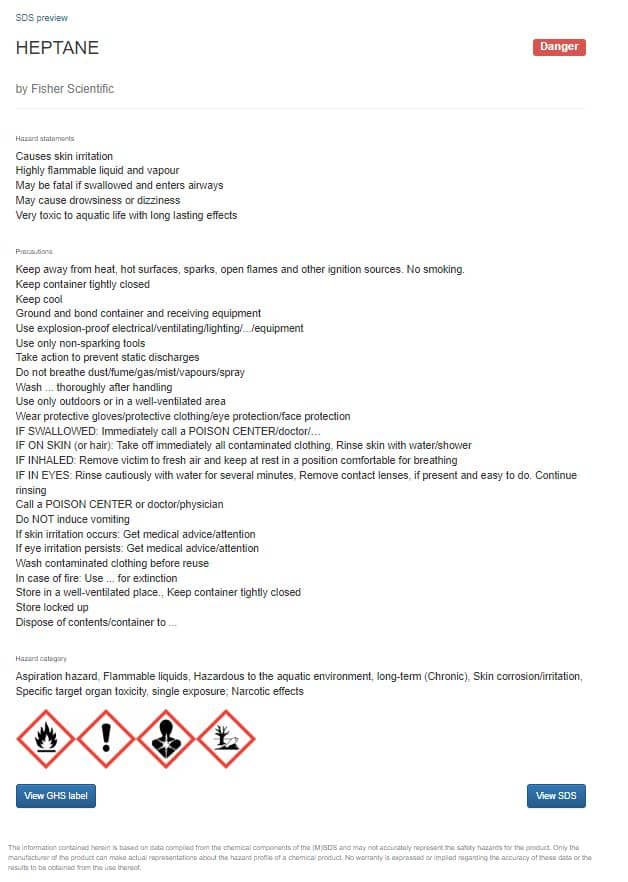Introduction
The safety of customers, suppliers, employees and the general public is always of the utmost importance to our laboratory. Following good laboratory practices will help us all have a safer and more enjoyable working environment, a win-win for everyone.
Induction plans
Lack of information is the biggest safety risk, as not knowing something is a risk to begin with means you are at maximum danger. Hence, we want to ensure everyone is well-informed about how to keep safe.
All new visitors (or not visited for longer than six months) to the laboratory must have a short and concise safety briefing of general laboratory guidelines and fire evacuation procedures before entering the working environment.
All employees will undertake training on laboratory safety processes, COSHH and fire awareness training as part of their induction training
COSHH (Control Of Substances Hazardous to Health)
Most of the laboratory working day involves very little risk in terms of chemicals, but specific tests involve using chemicals such as acids that are subject to COSHH. We want you to be safe when using these chemicals, and thankfully, each of the chemicals we buy comes with an MSDS (Material Safety Data Sheet) and a CAS number. Using your tablets, you can scan the CAS numbers and obtain the safety data for any chemical we use in the laboratory. We also have dedicated sample-related MSDS sheets to cover lubricating oils, fuels, coolants and Adblues to cover risks involved with the samples we receive. An example of the information obtained from the database search is below for Heptane. The advantage of the lookup is that there is no requirement to search through sheets of paper and that safety data can be retrieved instantly.

Moving equipment in the laboratory
The moving equipment in the laboratory is generally autosamplers and robotics. Many of these have touch stop control, safety guards and dedicated in case of emergency buttons. In addition, there are auditory messages e.g. “Robot will move in 10 seconds; stand back” when an instrument is about to start. These are all designed to prevent injuries to hands, but you should always wait until autosamplers are in safe loading positions before placing your hands into the space occupied by any robotics.
Heat sources removal with voice commands
As the fire triangle goes, heat is one of the key things to remove when preventing a fire. Since many plugs are located behind instruments or on the instrument, if it is not safe to approach, you will receive as part of your training voice commands you can use which automatically cut power to the device. This can be done in an emergency from outside the building without the risk of reentering.
Lab Specific procedures
Lab Supervisors must assess the risks and identify hazards associated with working in their area. Once hazards are identified, they must develop, implement and maintain lab-specific procedures to safely address high-hazard materials/processes, and then train laboratory personnel on procedures.
General safety principles
- Understand the known hazards associated with the materials being used. Never assume all hazards have been identified. Carefully read labels before using an unfamiliar chemical. Review the Material Safety Data Sheet (MSDS) for special handling information when appropriate (see COSHH). Determine the potential hazards and use appropriate safety precautions before beginning any new operation.
- Be familiar with the location of emergency equipment such as fire alarms, fire extinguishers, emergency eyewash, and shower stations and know the appropriate emergency response procedures.
- Avoid distracting or startling other workers when they are handling hazardous materials.
- Use equipment and hazardous materials only for their intended purposes.
- Always be alert to unsafe conditions and actions and call attention to them so that corrective action can be taken as quickly as possible.
- Wear appropriate skin, eye and face protection.
- Always inspect equipment and protective equipment for leaks, tears or other damage before handling hazardous material. This includes fume hoods, gloves, goggles, etc.
- Never eat, drink or taste chemicals and avoid smelling chemicals wherever possible.
Hygiene
- Avoid direct contact with any hazardous material. Know the types of protective equipment required while using any chemical. If in doubt, review the appropriate section of the MSDS.
- Tie Back long hair and loose clothing, and always wear footwear that fully covers the feet.
- Under no circumstances mouth-pipette. This is a gross misconduct dismissal offence.
- Use appropriate safety equipment whenever there is a potential for exposure to hazardous gases, vapours, or aerosols. Check to ensure that exhaust ventilation equipment is working properly before use. In the event that general or exhaust ventilation is not functioning properly, immediately stop work, notify the facilities manager, and place a sign to notify others that work with hazardous materials is suspended until the equipment is working properly.
- Wash thoroughly with soap and water after handling chemicals or biological materials, before leaving the laboratory and before eating or drinking.
- If there is a hazardous splash potential, splash goggles shall be worn as eye protection.
- Clean and store personal protective equipment as appropriate.
- Laboratory employees shall be familiar with the signs and symptoms of exposure for the materials with which they work and the precautions necessary to prevent exposure.
Eating and Drinking
- Avoid eating, drinking, smoking, vaping or applying cosmetic products in any laboratory area where hazardous chemicals or biological hazards are in use.
- Refrigerators and microwave ovens used for chemical or biological storage or other laboratory use shall not be used for food storage or preparation.
- Areas with black padded and slip protection flooring are to be considered lab space even if no hazardous materials are used in that area.
Good Housekeeping
- Keep work areas (including floors) clean and uncluttered. Clean up work areas after the work is finished or at the end of each lab or workday.
- Dispose of waste per the environmental disposal policies. A separate container must be designated for non-contaminated glass. Oil Contaminated glass is considered hazardous waste and disposed of accordingly.
- Clean spills immediately and thoroughly, per the guidelines in this document and the product MSDS. Ensure a chemical spill kit and oil absorbent material are available. All staff will receive training on cleaning a spill during their induction training, and a designated employee shall ensure that the spill kits are properly stocked as part of the company stock control procedures.
- Do not block exits, emergency equipment or controls.
- Assure hazardous chemicals are properly segregated into compatible categories.
- All waste shall be handled by lab staff, no business property cleaners are to enter lab spaces.
Hazardous material handling and storage
- Chemical containers with missing or defaced labels should not be accepted.
- Chemicals utilized in the laboratory or hood must be appropriate for the type and capacity of the ventilation system.
- Hazardous materials should be stored in appropriate safety cabinets, closed cabinets or not more than five feet above the floor.
- Chemicals shall be segregated by compatibility.
- Hazardous material storage areas must be labelled as to their contents
- Storage of hazardous materials at the lab bench or work area shall be kept to a minimum.
- A Hazardous material mixture shall be assumed to be as toxic as its most toxic component.
- Substances of unknown toxicity shall be assumed to be toxic.
Transferring materials
- Carry glass containers by the underside of the bottle; never carry them by the lid
- When moving hazardous materials on a trolley, use a trolley suitable for the load and with raised edges to contain leaks/spills.
- Waste must never be transferred between buildings and only directly from the lab to the approved waste contractor.
Compressed Gases
- Cylinders with regulators must be individually secured.
- When storing or moving a cylinder, have the valve protection cap securely in place to protect the stem.
- Cylinders must be secured in an upright position at all times. Use suitable racks, straps, chains, or stands to support cylinders against an immovable object, such as a bench or a wall, during use and storage. Do not allow cylinders to fall or lean against one another.
- Use an appropriate cart to move cylinders.
- Never bleed a cylinder completely empty. Leave a slight pressure to keep contaminants out.
- Oil or grease on the high-pressure side of an oxygen cylinder can cause an explosion. Do not lubricate an oxygen regulator or use a fuel gas regulator on an oxygen cylinder. Use an oxygen-approved regulator.
- Always wear goggles or safety glasses with side shields when handling compressed gases.
- Use appropriate gauges, fittings, and materials compatible with the gas being handled.
- Outside contractors/suppliers have been hired to exchange empty cylinders with full ones. Lab staff should limit moving cylinders, but use the cylinder restraint cart when necessary.
Unattended Lab Operations
- Check with your laboratory supervisor to determine if the operation can be left safely unattended. For the majority of robotics in the lab, this can be left unattended and will auto-shutdown when complete. Any ignition or heated tests above 100’C cannot be left unattended, even those with dedicated fire suppression systems. This includes furnaces and ovens. The exception to this is RPVOT, which must be checked every 2 hours if the test is completed or every 6 hours after 6pm to confirm test has completed and power shut down remotely when test has finished.
- For non-autosampler operations for wet chemical tests, a warning notice must be posted near the experiment if hazardous conditions are present. This notice must contain information concerning the hazard, such as indicators of problems and who to contact if such evidence is present.
Lone Worker
In no case is working alone permitted during procedures involving highly hazardous or toxic chemicals or agents and/or dangerous equipment or environments (i.e.: anything that could cause severe injury or death).
Laboratory security
All laboratory facilities must be keycard access only and monitored with 24-hour CCTV to ensure the working environment is safe.
Working Hours
Tiredness is a common cause of safety protocols not being adhered to. The laboratory shall operate in such a way that no employee exceeds UK recommended guidance on working hours and on-call staff should have sufficient rest time before the next shift after being on call.


